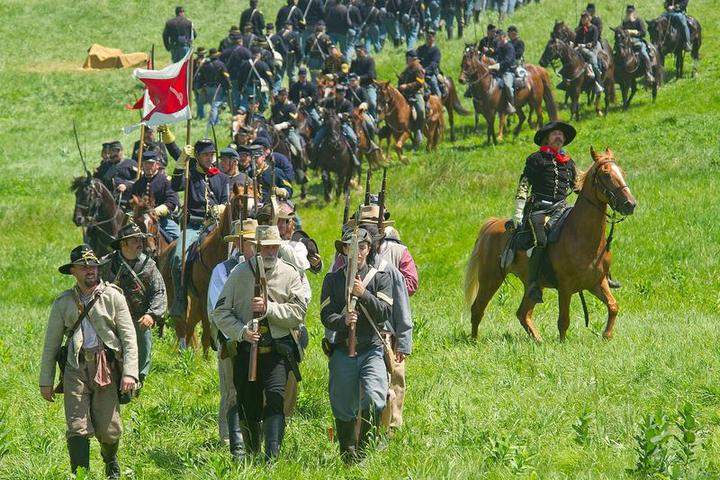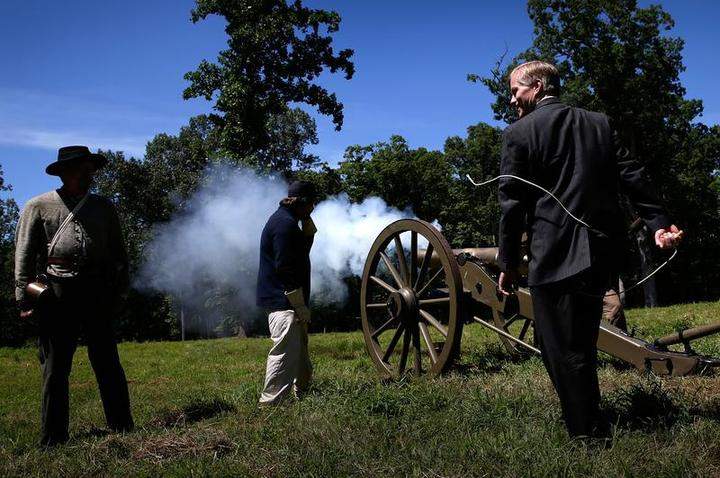FREDERICK, Md. – About 150 years after the “Battle that Saved Washington,” journalist and Civil War buff Keith White leads a dozen friends on a tour of the farmland south of here where Union forces led by Maj. Gen. Lew Wallace were credited with delaying the Confederate advance toward the nation’s capital.

The group will spend nearly three hours hiking many of the half-dozen or so miles of trails at the Monocacy National Battlefield, listening as White relays details of the July 9, 1864, battle, which resulted in more than 2,000 casualties in a Confederate victory.
“It’s not just a hike, but there’s something additional,” he says in an interview later. “You can go to a battlefield and get a little sense of that history.”
There are more than 300 miles of trails to explore in the 24 U.S. national parks designated as significant battlegrounds of the Civil War, according to figures provided by the National Park Service. The Manassas National Battlefield in Virginia, for example, has more than 40 miles of trails; Pecos National Historical Park in New Mexico has just two.
The 24 battlefields drew nearly 10 million visitors last year.

Get daily National news
“Each one is unique, yet the vast majority share things in common,” says Mike Litterst, a National Park Service spokesman. Most have a visitor’s centre and a museum to help put the site in context. Many have park rangers or volunteers who give walking tours.
And these aren’t the only preserved Civil War battlefields. Others are under state, local or private jurisdiction.
“Some 10,500 armed conflicts occurred during the Civil War, ranging from battles to minor skirmishes,” the Civil War Sites Advisory Commission said in a report to Congress in 1993. Of those, 384 were determined to be “principal battles” that had a significant impact on the course of the war. Those battles occurred in 26 states.
“The war really did touch pretty much every corner of America,” said Mary Koik, deputy director of communications for the Civil War Trust, an organization that works to preserve the battlefields.
“You have battles fought from Pennsylvania all the way out through New Mexico.”
Some people may use the battlefields for fitness or recreation, a place to walk the dog or take a stroll with the kids and be out in nature.
The Kennesaw Mountain National Battlefield Park near Atlanta is historic, but also “quality outdoor space,” Koik said.
Surveys done by her group, however, indicate that most park visitors are interested in the history.
Before visiting a battlefield, White recommends reading up on it. You can get information about the battlefields on the Civil War Trust and National Park Service websites, or pick up brochures and maps at the visitor centre. “It’s also good to sit down and talk to a ranger,” White said.
Markers along the way will point out historical spots on the battlefield and give you a snapshot of what occurred there.
“By visiting these in succession, in the right order, you’ll see how the battle unfolded,” Koik said.
Before his tours, White does research on the battle fought there and prepares a script. “Usually, time permitting, I will go up and walk the trail before I lead the tour so I’m not caught unaware.”
White became interested in the Civil War after learning that he had ancestors on both sides of the conflict. He also volunteers at the site of the Battle of Chancellorsville, part of the Fredericksburg & Spotsylvania National Military Park in Virginia. He plans to lead friends on a tour of two additional battlefields this year.
“The more you learn, the deeper you get into it,” he said. “There are so many people and so many story lines involved.”
The National Park Service and the Civil War Trust also have free GPS-based smartphone apps that will act as tour guides for some of the parks.
“We think the most important thing is to get people out to see these places,” Koik said.


Comments